Arizona’s Navajo Nation
Posted on January 30, 2016 by bob in Travel
The ruts are long and narrow, some measure nearly a foot in depth. As the driver swerves to avoid 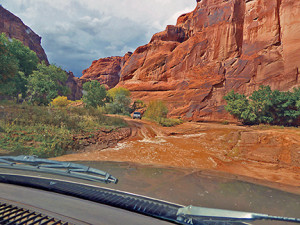 them, he plows across a shallow river, causing the van to list and my head to bang against the door of the four-wheel drive. I envision a muddy death.
them, he plows across a shallow river, causing the van to list and my head to bang against the door of the four-wheel drive. I envision a muddy death.
My husband and I are on an aptly-named Detours expedition, one that aims to explore not only the scenic spots but also the cultural heritage of Arizona. Our particular tour focuses on the state’s native people, and we’ve definitely lucked out. Our guide is Donovan Hanley, a member of the Towering House Clan of the Navajo, who sports a waist length braid, a broad smile and a striking turquoise necklace. He’s about as authentic as you can get.
“Yá’át’ééh abíní [good morning], ” he says. “Welcome to Diné Bikéyah [The Navajo Nation].”
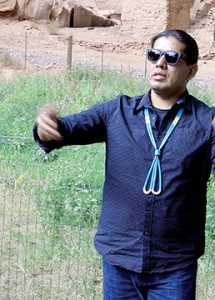
Our Navajo guide explains the meaning of turquoise and the symbolism of his necklace.
During the next four days, as we travel to some of the Navajos’ most sacred spots, he intersperses facts about his people’s beliefs and customs with personal stories about his grandfather (a medicine man), his father (a sheep herder), and his eight-year-old niece who still lives in the same town where he grew up.
As for his necklace, he tells us that the turquoise stones symbolize creation. Like the sky and water, they provide security and protection.
“The strand on the right is my mother,” he says. “The one on the left is my father. And the loop at the bottom, the strand that connects them, is the umbilical cord. By joining together, they have created me, the future generation.”
Donovan grew up near Monument Valley, a 30,000-acre tribal park
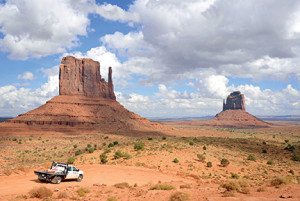
The Mittens are two of the most distinctive buttes in Monument Valley.
near the Arizona/Utah border. The land is filled with stark rock formations that are familiar to most of us from countless movies that depict the American West. But to the Navajo, the sandstone rocks are more than a filmmaker’s prop; they reflect their way of life and represent some of their deepest convictions.
We tour the Valley in an open-air vehicle driven by a specially-licensed Navajo guide. In the distance I see The Mittens, a pair of massive buttes that look like the hands of a gloved giant.
“The giant is so big that he can safeguard us,” says the guide. He continues past spots where medicine men pray, where prospectors have discovered silver, and where a tall, solitary spire resembles the fireplace in the center of a traditional Navajo hogan (home).
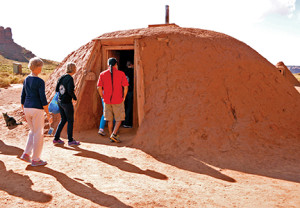
Navajo Hogan.
Before leaving the Valley, we stop at a hogan to learn about the techniques and beliefs surrounding crafts like spinning and weaving. A weaver explains that authentic blankets and baskets always have a “spirit line” that allows the artisan’s creativity to be used anew on subsequent projects.
Although Monument Valley has been inhabited for thousands of years, it’s the red geological formations — the tall, skinny buttes and wide, flat mesas — that are the real attraction. For up-close views of the petroglyphs and cliff dwellings that show the human history of Navajoland, we head to Canyon De Chelly National Monument.
A light, gentle rain — a female rain, says our driver — bathes the cottonwood trees with a soft sparkle and brightens the green that peeks out from the rocks. We see the farms that belong to the 50 or 60 families who live in the canyon today, study the dwellings left by the ancients, and listen to our driver tell stories about his childhood, when he was raised by his grandmother and slept on a sheepskin tossed on the floor of her hogan.
We’re admiring a Puebloan compound perched in a canyon alcove far above us when the sky is split by a
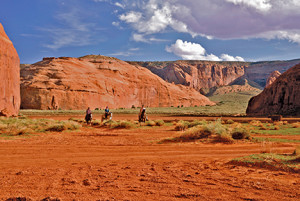
Visitors enjoy horseback tours through Monument Valley.
flash of lightening.
“No problem,” says the driver. “The rain will come from the right. I will turn my van to the left.” He careens along the bumpy road, outrunning the rain — the heavy male rain — that pelts the ground off to the right.
Donovan laughs when we thank him for arranging another authentically Navajo experience.
“Power,” he says, “lies with those who can read the clouds.”
En route back to Phoenix, we stop at Hubbell Trading Post, the oldest continuously operating trading post in the country. At first glance, it’s a mix of groceries, dry goods and run-of-the-mill souvenirs. At second, it’s a repository of outstanding Indian art, from antique rugs to modern creations.
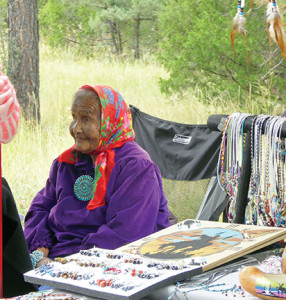
An elderly craftswoman enjoys displaying her own work along with that of other family members
As the resident historian tells the story of a Yei rug, a small, woman with long gray hair walks in, carrying a large, paper-wrapped package. She is, says the proprietor, a master weaver, still practicing what threatens to become a lost art. Two women vie to purchase the rug; the visitor from Sweden wins.
As for me, I settle for a simple souvenir that I find at a nearby convenience store. It’s a 9” doll outfitted with a necklace similar to Donavan’s. For $8.95 I have security, protection and wonderful memories.
For more about Arizona’s Native culture and other Arizona attractions, visit www.Traveltizers.com. For more about Detours guided tours, see www.detoursaz.com. λPrime









